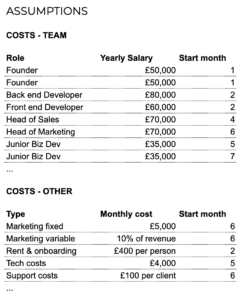The post How to budget as an early-stage startup appeared first on Beyond.
]]>Now is the time to show future investors they can trust you by building a beautiful budget – because naturally, you know what you’re doing!

Exciting possibilities lie before you – how are you going to allocate your funds? How much to hiring? Product? Marketing? Unlimited coffee?
This is where the trusty spreadsheet comes in… an inevitable recurring character for all startups.
1) Expense budgeting
For each cost, write down the amount and the month it starts. So if you’re hiring a software engineer, you’d write their annual salary and the month you plan to hire them. Once all your lines are written down, the magic of spreadsheets lets you automatically break this down into monthly costs.
2) Revenue budgeting
Do the same for your revenue plan. Divide it into different lines representing your income sources, factoring in all the stuff you tried to forget from school: customer acquisition costs, expected growth rate per channel, recurring versus one-off revenue etc. Add in any one-off cash injections like the money you managed to convince your elderly neighbour to ‘invest’.
Tips and tricks
When building expense and revenue budgets, you can make things more complicated (and thus more impressive!) by using drivers, formulas and percentages.
For example, you might want your marketing to scale with a percentage of your revenue, your support and infrastructure costs to scale with your number of clients, or your rent and onboarding costs to scale with number of employees.
3) Bringing it all together
One handy way to do this is to use multiple spreadsheet tabs with your different assumptions, and a tab putting everything together within a monthly view. Here you want a line subtracting your expense from your revenue (this is your profit/ loss), and a line that adds up this line cumulatively to get your ending balance.

Now you can work out some key budgeting stats:
- Runway: the month before all goes to shit and you run out of money.
- Cashflow positive: the month when you can organise a massive party because YOU’RE MAKING A PROFIT!!!
From this you can decide if you need to tweak your budget (eg decrease expenses), when to budget more expenses (eg new hires), when to raise a round (once you’ve proved scalability but far in advance of your max runway month), and when to despair.
Tracking your budget (rather than let it rot in your Google Drive)
As founder of an early-stage startup, you get the amazing privilege of coming in every month or so and course-correcting assumptions: increasing expenses when your junior BizDev accidentally miss-types an extra 0 in their ad campaign cost, or increasing revenue projections after managing to convince a client to sign up for the “Ultra-Premium” package.
A good practice here is to copy your budget before you adjust it, so you can keep track of how terrible your predictions are over time. You can get expenditure and revenue data from your accounting system or, because there’s few actuals at this stage, directly from your bank.
Crucially this is a chance to adjust your strategy as you go, rather than blindly charge into a wall. If you’re making a lot less revenue than expected, you might want to delay expenditure. If you’re making more, you want to accelerate instead. If your runway date starts to loom closer and your revenue is nowhere near your predictions, it’s time to re-evaluate your (company’s) life.

Good luck, and happy budgeting!
About me:
I’m the founder of Beyond, providing budgeting software for fast-moving SMEs. Beyond automates the day-to-day, so budget holders and finance teams can spot risk and confidently plan for the future.
The post How to budget as an early-stage startup appeared first on Beyond.
]]>The post Rethinking the finance function in the age of robots appeared first on Beyond.
]]>Coming for our data, coming for our jobs, and (if the more dramatic reports are to be believed) coming for our very existence.

Or are they?
Let’s pick apart the A.I. fact from the hype and see where the real opportunities lie for the future finance function.
They are already here
A.I. is already transforming core functions of a typical accountant. Repeated processes based on structured data are ripe for automation. Things like:
- Invoice chasing
- Matching and reconciling transactions
- Invoice coding
- Anomaly and fraud detection
After all, A.I. is measurably faster and more accurate than us fleshy meat-bags at these repetitive tasks. And besides, this work is pretty boring anyway…
They are getting smarter
Nerves start to jangle when we see the next wave of intelligence starting to be deployed. Recent advancements in natural language processing and machine learning helps A.I. deal with both the nuances of text and the ever-present ambiguity of a business’s finances. This brings a far greater swathe of traditional accountancy work into reach. We are starting to see:
- Fully automated bookkeeping
- Advanced report creation and statutory filings
- Analysis of legal and tax documents
- Deep predictive analytics
- Smart audit assistants
Certainly starting to encroach on some classic value-add activities of a typical finance function.
[You don't need to see another generic yet ominous picture of a robot using a keyboard]
(what kind of self-respecting robot needs to use a keyboard anyway...??)
Expectations are changing
People’s beliefs of what technology can do for us is fundamentally changing. Across almost all industries, there is a growing expectation that automation will be bundled along with core services. As we shop online, we expect to see helpful recommendations; as we get into a car we expect it to direct us to our destination (and soon to take us there altogether); as we bank we expect to get smart alerts and reminders.
Accounting is no different. There will, of course, be adjustments needed as traditional tasks are commoditised and old revenue streams dry up, but this also raises huge opportunities. This is not a zero-sum game.
A prosperous co-existence
In a business context, A.I. is nothing without people.
While A.I. unlocks accounting superpowers, finance professionals are needed to put them to good use. Tool selection and setup, ongoing interpretation and tuning, and – of course – accountability are all roles which will need a human touch for the foreseeable future. After all, with great power comes great responsibility.
More importantly, as accountants’ time is freed up from menial tasks, they can shift their focus to a higher level, the strategic objectives of the company. Advisory services will become a fertile and lucrative hunting ground. Goodbye business policeman, hello business partner.

Power to the people
Vendors will often say you just need a smart new machine learning tool or shiny dashboard to gain a magical insight into a business. However, as any good A.I. engineer will tell you, an algorithm is only as good as the data it has access to.
This means, when trying to truly understand the workings of a business, you have to engage the real driving force – its people. Their knowledge, understanding of risks and plans for the future are always essential for true insights.
Here, A.I. can be an enabler – removing bottlenecks and giving people superpowers.
And ultimately it is a tool of empowerment – helping information flow more freely and enlightening decision-making.
Not so scary after all.
Bringing this to life
In order to build this deep partnership, it’s essential that your systems:
- Truly understand the business at its most granular level – its people and the context of all activities across the organisation.
- Always contain the most up-to-date data, link with all your tools, and can quickly flag issues, anomalies and opportunities as – or before! – they arise.
- Enable the company to quickly act on the decisions that can be made from this data.
We’ve created Beyond around these exact demands, deploying A.I. in a way that puts people – not robots – at the centre.
This post originally appeared as an article on AccountingWeb
The post Rethinking the finance function in the age of robots appeared first on Beyond.
]]>